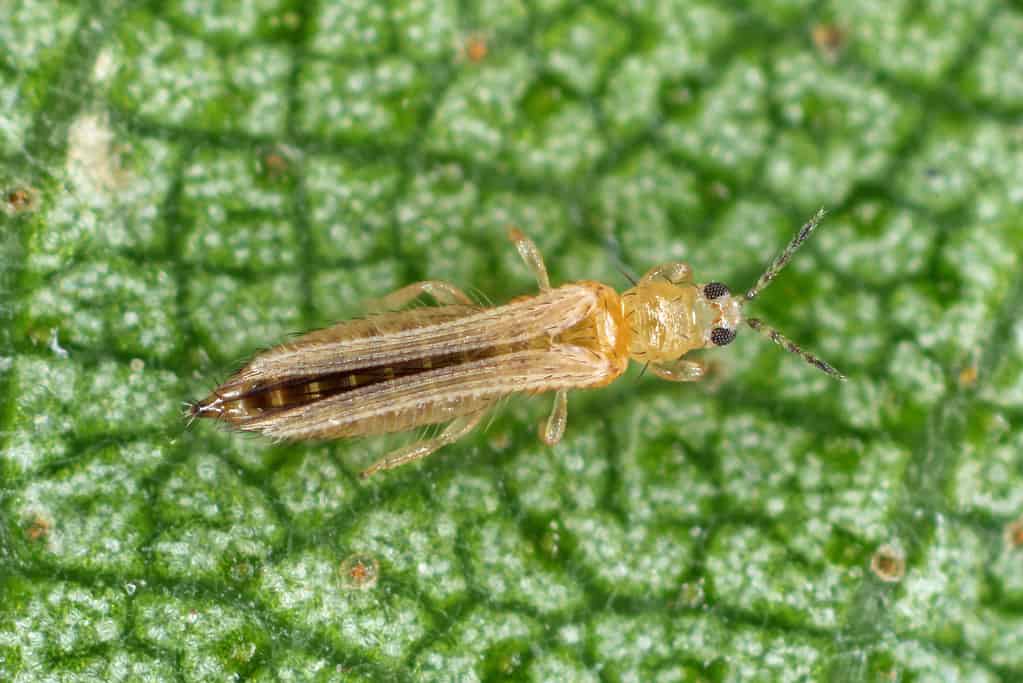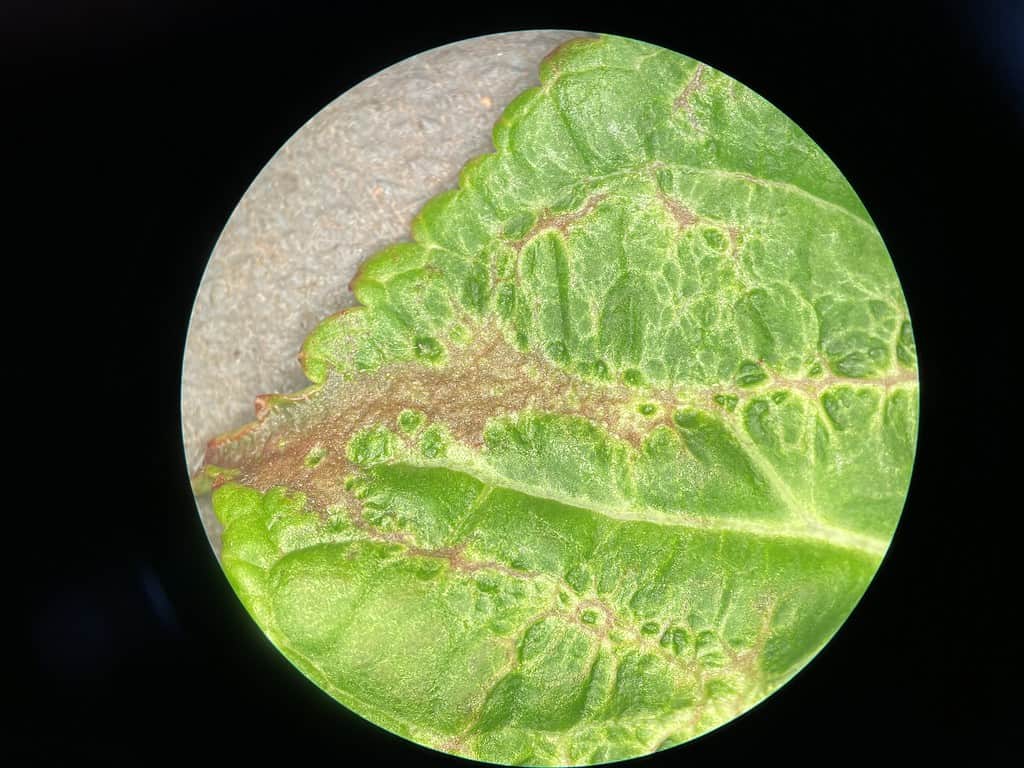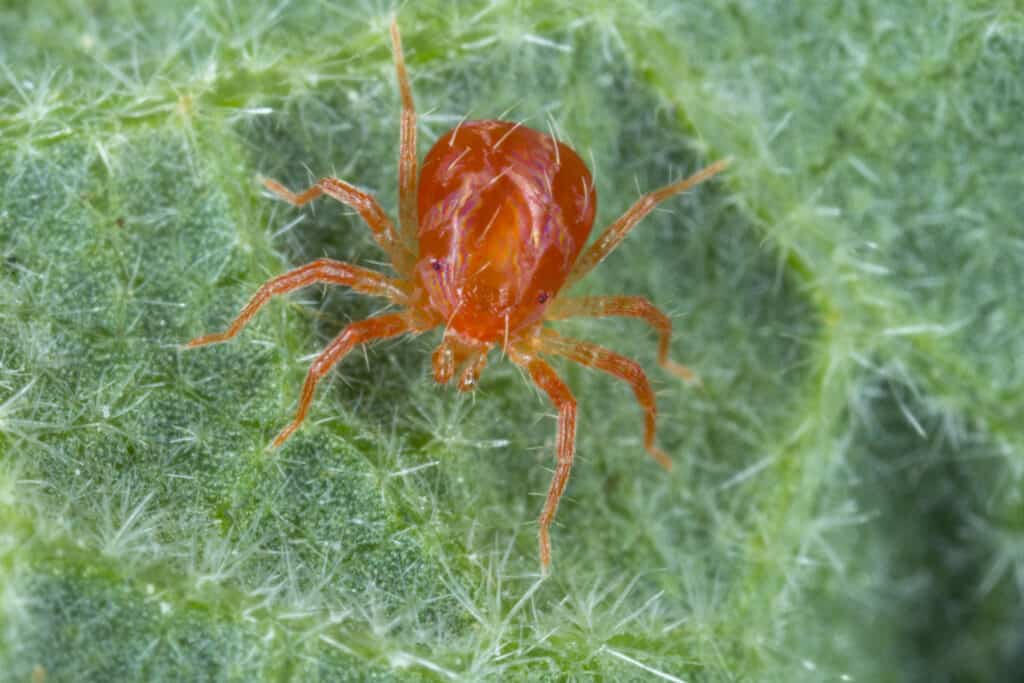There’s nothing worse than discovering an infestation of pests harming your precious plant life. Don’t beat yourself up about it, though. These things happen inevitably every so often, even to the most experienced of gardeners. The most difficult aspect of an infestation is sometimes not the how aspect of removal, but the what. That is precisely what this article serves to do- assist you with the identification of a particularly creepy crawler, the thrip.
Thrip identification can prove tricky at first, because of their similarity in both appearance and behavior to many other common plant pests. With the help of a well-trained (and well-read) eye, however, your thrip troubles can be alleviated in no time! So, let’s determine whether or not your plants are suffering at the hand of thrips, and if so, get them swiftly addressed.
How To Identify A Thrip

Adult thrips are tiny, measuring up to 1.5 mm in length (and those are the big ones)!
©Tomasz Klejdysz/Shutterstock.com
The thrips identification process becomes easy once you learn their appearance and telltale infestation signs. An adult thrip will be quite slender, and though they are visible to the naked eye, they can’t be studied too closely as they measure only 0.5 to 1.5 mm in length. In terms of coloration, this can vary based on species. As a general rule, though, a thrip will be yellow, brown, or black in color. Young thrips, referred to as “nymphs,” are typically lighter in color. Sometimes they will even be a light green or pale yellow. When they’re nymphs, they’ll also sometimes have striking red eyes.
All that said, you probably won’t be able to identify these characteristics just by glancing down at your plant. To the naked eye, they might just look like small dark spots on your plant’s leaves. Specifically, their underside. Making them even harder to identify is their tendency of hopping away once they spot you!
Different Species of Thrips
Thrips are a group of insects that are very diverse, with over 6,000 different known species. It would be a monumental (and fairly pointless) task to discuss each and every one of these species, so instead, let’s highlight those which are most commonly found. These descriptions are brief and do not cover the entirety of these creatures’ complexities, but they serve as a quick way to compare their preferences and behaviors.
Thrips tabaci (Onion Thrips): These pests are known to ravage onion plants and other allium crops. Although, that doesn’t mean they’ll avoid other plants. Known to transmit a number of plant viruses, the most common offender is the Tomato spotted wilt virus (TSWV).
Frankliniella occidentalis (Western Flower Thrips): One of the most widespread and series species of thrip, they are known to greatly damage a large variety of both agricultural and ornamental plants. Much like Onion Thrips, they are known to carry TSWV as well.
Scirtothrips dorsalis (Chilli Thrips): If you have pepper plants, you might run into these sneaky creatures. Though they won’t stray from your other crops, this species prefers the pepper plant and will stop at nothing to cause pesky discoloration and leaf curling.
Heliothrips haemorrhoidalis (Greenhouse Thrips): These thrips tend to enjoy the climate of greenhouses, and are especially easy to identify. That’s because of their unique coloration, which is so dark it nearly appears to be black.
Signs Of A Thrip Infestation

If you notice yellow spots and lines on the leaves of your plants, it can be indicative of thrip damage.
There are a number of signs that you should look out for if you begin growing suspicious of a thrip infestation. If you can visibly see some sort of pest, but your plant damage doesn’t align with what’s described here, then you can assume that the insect you’re falling victim to isn’t actually a thrip. Once you understand what kind of damage thrips cause, you’ll be able to manage thrip identification much faster and easier.
The way in which thrips feed is by sucking the sap from your plants. This leaves behind little patches of discoloration on your plants, with leaves being their favorite feeding area. When leaves and fruits are damaged by thrips, you’ll notice a sizable amount of shriveling and even some curling. There is actually a strong difference between thrip damage on a young and old leaf. When older leaves are damaged, a distinct silvery tone is left over. Whenever a thrip damages a younger leaf, the spots left over manifest as yellow and orange in hue. These spots might also seem a bit bumpy to the touch.
Another, much grosser, way to identify thrips is by their fecal matter. Thrips poop decisively, often all over the leaves of your plant. Thrip feces manifests as small black dots, and while single dots are hard to see, you’ll certainly notice as these spots accumulate and the infestation worsens.
Making Sure Thrips Don’t Return
The easiest process for thrip removal is a bit time-consuming but well worth it. It involves cutting off parts of your plant that are infested and throwing them out, then weeding and removing debris from your plants as well. Once that’s done, you can begin to spray your plants with neem oil or some kind of insecticidal soap. When doing so, be sure to concentrate on the undersides of leaves because this is the number one hangout spot for the thrip!
Another strong method for ridding your garden of thrips is by naturally phasing them out of the area’s environment. This can be done through the introduction of other insects, ones that are good for your plants but incredibly bad for thrip life. In this way, the population can be naturally controlled with little interference on your part. Some insects that are natural thrip predators include lacewings, ladybugs, and even wasps (though you might not opt for this choice).
Other ways to ensure that this problem has been solved for good is to pay closer attention to crop rotation, which can end their life cycles, and to watch how often you’re fertilizing your plants. Since thrips are attracted to large amounts of nitrogen, overfertilization might unintentionally attract more of these pesky insects. And, of course, make sure you’re generally paying close attention to the needs of your plants. When plant life becomes stressed, it is not only more susceptible to thrips but other pests as well.
Pests You May Mistake For Thrips

Due to the species’ similarity in behavior, many gardeners can initially mistake spider mites for thrips.
©Tomasz Klejdsz/Shutterstock.com
Sometimes, the most major trouble one can have with thrip identification is distinguishing these insects from the countless others known to attack plants. There are many creatures that exhibit similar traits, and thus might cause you to have some errors. Either you’ll have a thrip infestation and think it is another pest, or you’ll be certain that thrips are attacking when in reality, it is something entirely different. Here are some of the most common offenders when it comes to the misidentification of thrips.
Spider Mites: Spider mites have a lot in common with the thrip. For starters, they create very similar damage patterns. It’s not uncommon to see the same silvery tones and discoloration as thrips. In addition, they both love to hide underneath the leaves of plants. A good way to distinguish the two is by coloration, as adult spider mites are typically a warm red or brown.
Whiteflies: Whiteflies resemble thrips in many ways, especially in the damage that they cause to the plants they inhabit. However, whiteflies are given away by their white coloration and moth-like appearance when in flight.
Aphids: It’s pretty natural to assume aphids are attacking your plants. After all, they’re incredibly common, and there are several different kinds to be worried about. Both aphids and thrips cause noticeable damage, but their colors and body types make them distinguishable. Aphids are typically round or pear-shaped and often appear in shades of green. Thrips, on the other hand, are slender and usually appear yellow or brown.
The photo featured at the top of this post is © iStock.com/Tomasz Klejdysz
Thank you for reading! Have some feedback for us? Contact the AZ Animals editorial team.







